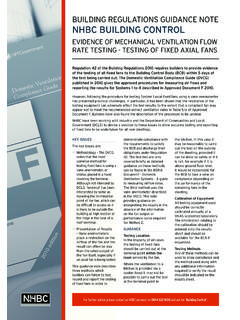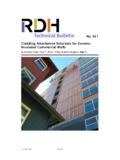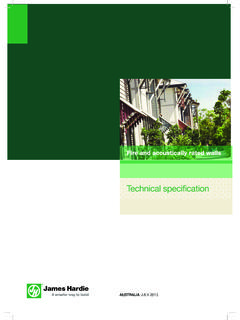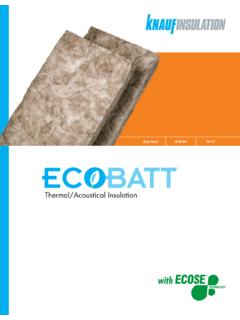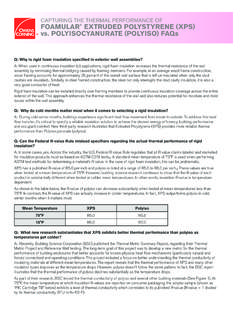Transcription of NHBC’s technical newsletter
1 EXTRANHBC s technical newsletter December 2005 Issue 34 This edition includes:Electrical safety in steel framed wallsA reminder to check cabling is located in safe zones to protect it from damageStructural Insulated Panel SystemsWe take a look at this Modern Method of Construction and provide guidance on the things to look out forCorbellingNHBC has encountered problems with corbelling on site, we take a look at acceptable methods ofthis masonry detailKeeping up appearancesAdvice on construction detailing to make sure your homes do not fall victim to water staining4532A project certificate is needed to certify that the design ofthe specific buildings meets with the requirements of theNHBC Standards and this should be available to nhbc on site. We are currently recruiting steel frame certifiers to join ourlist. Applications will be considered from professionallyqualified civil and structural engineers with at least threeyears experience in the design of light steel you are interested please contact nhbc safety in steelframed walls2 Wanted steel frameproject certifiers3 Structural Insulated Panel Systems4 Corbelling5 Keeping up appearances6 Letterbox heights6 nhbc Training vibrationand noise at work6 Building for tomorrow 20067 nhbc launches new websitefor builders and developers7 Questions & AnswersCONTENTS2 STANDARDS EXTRAWhen electrical cables are installed in steel framed walls and partitions they must be locatedso that they are either protected from mechanical damage or are installed in safe zones.
2 Electrical safety in steel framed wallsThe sketch below shows situations wherecables may be run in walls less than 50mmfrom the surface. This is in accordance withclause 522-06-06 of BS 7671 Requirementsfor electrical installations .Cables need to be installedby a competent personwho is familiar with therequirements of BS cable tailsdangling from the ceilingand hoping the dry linerwill correctly install themin the partition is notacceptable. He may be anexpert in dry lining but isunlikely to have beentrained in how to position cables safely, andto provide grommets to prevent chafing,where they pass through the head or baserails, or a can easily be damaged duringconstruction by drill bits or fixings and thecable position may be inadvertently movedout of the safe zone. Following trades andeventually the homeowner will rely on thecorrect positioning of cables when theycome to fix things to the electrical contractor must be satisfiedthat the installation meets with BS 7671 inorder for him to sign the completioncertificate.
3 He needs to be certain thatcables are correctly installed and in the rightlocation to do this. Leaving it to chance isnot an - steel frame project certifiersNHBC Standards Chapter Light steel framed walls and floors was published in April 2005 and became effective in July 2005. ActionBuilders need to be aware of the safe zonesand check to see that cables are correctlylocated before the boarding is fixed. Safe zones for electrical cables3 STANDARDS EXTRAH omes with SIPS walls usually have upper floors formed withI-joists, metal web joists or timber joists, and these should bedesigned in accordance with nhbc Standards Chapter Timber and concrete upper floors .Like timber frame construction, the adequacy ofconnections between the panels, and between the panelsand other components, are absolutely vital to thestructural performance, durability and weather-tightnessof the planning of internal services is extremely importantto ensure that wherever possible there is no disturbance to the load-bearing wall panels.
4 Where this is unavoidable,consideration must be given on how to overcome thepossible adverse effects on structural, thermal and acoustic cladding to the SIPS structure should be designedin accordance with nhbc Standards Chapter Curtainwalling and cladding and in all circumstances a minimum15mm drained and ventilated cavity is required between thecladding and the panels. As with timber frame, a breathermembrane is needed to provide temporary protection duringthe construction satisfy nhbc technical Requirement R3, SIPS arerequired to have a design life of at least 60 years, andconsistent with our requirements for other proprietarybuilding systems, SIPS will need to achieve satisfactoryindependent assessment before we can accept their use onhomes covered by independent assessment should be carried out by anappropriate technical approvals authority accepted by nhbc ,including BBA (British Board of Agrement), BRE (BuildingResearch Establishment) certification, or BM TRADA (TimberResearch and Development Association).
5 We would expect the independent assessment to bethorough and cover a range of issues including structure,fire, thermal and acoustic performance, air tightness,durability and weather resistance (cladding), fabrication,delivery, storage and Insulated Panel SystemsActionIf you are considering using SIPS for any part of a home tobe covered by the Buildmark, make sure that the design,fabrication and construction comply with nhbc make sure that the panels have undergoneappropriate independent assessment to confirm they willachieve satisfactory in-service performance for a design lifeof at least 60 growth in the use of modern methods ofconstruction (MMC) in the new homesmarket, in part fuelled by the ODPM Designfor Manufacture competition ( 60,000 homecompetition), this article features oneparticular form of MMC, Structural InsulatedPanel Systems (SIPS).
6 SIPS are engineered building panels, manufactured in acontrolled environment and shipped to site ready forerection. There are many variations in the type of SIPS available, but typically they comprise an inner rigid insulatingcore of expanded polystyrene (EPS) or polyurethenesandwiched between two outer skins of board orientedstrand board (OSB) or cement-based board. The board isnormally bonded to the insulation with proprietary adhesiveusing a press to ensure a bond over the entire surface area. Variations can include the use of different boards or insulation,the addition of strategic timber studs into the insulationcore, and alternative methods for fixing the board to thecore. The finished panels need to be handled with care aftermanufacture to prevent damage and possible de-bonding ofthe materials. SIPS can provide theexternal load-bearing walls and roof of abuilding, together with itsload-bearing and non load-bearing internalwalls.
7 SIPS can also beused to form the externalinfill walls of structuralconcrete or hot rolledsteel framed EXTRAThe corbelled masonry eaves detail shown above is rotatingabout its base as a result of its eccentric self-weight and the weight of the proportion of the roof construction that it is details must be carefully considered and simple guidanceis provided in nhbc and British Standards in order to: ensure the stability of the corbelled portion of masonryand provide an adequate factor of safety againstoverturning avoid local crushing of the masonry limit the eccentricity of loading to the supporting part ofthe wall prevent tension developing in the masonry where it hasnot been designed forWhere courses are corbelled, the extent of the corbelling islimited as shown in the figure below unless the work isotherwise supported or variation from the above should be designed by asuitably qualified chartered engineer in accordance withBritish Standards and Codes of Practice and submitted toNHBC for masonryExtent of corbelling (Clause - S2j)Corbelling is a detail that is sometimes also used to providesupport for dummy not correctly supported, a large chimney, which may weigharound 3 tonnes, could be just waiting to fall through the roof.
8 A system, such as theone shown to the left, would not beacceptable to nhbc asit varies from thebasic guidance andrelies on the roofmembers andconnections to providesupport for which theyhave not engineered gallows bracket can provide a substantialplatform to support the dummy brick or oversailing is a masonry detail where the courses of masonry units projectbeyond the face of the course below as a series of cantilevers. It is used to achieve functionaland decorative chimneyUnacceptable detail Engineered gallows bracket5 STANDARDS EXTRAK eeping up appearancesStaining of external walls of homes is at bestunsightly and at worst the start of waterpenetration to the fabric and ultimately tothe inside of the building. Rain falling evenly on the external walls will generally not bethe cause of a staining problem. However, where the water ismore concentrated, typically below window sills, walls canbecome saturated.
9 Over time this can change the appearanceof the building and potentially lead to complaints fromhomeowners. The type and colour of bricks used for theexternal walls can highlight the problem, with lighter colouredbricks showing up any dampness more than darker problem is not confined to wall areas beneath sills, it canalso occur to parapet walls and gable best way of reducing staining is to have sills, copings etc,which project beyond the wall below and are provided with asuitable throating or drip. This should ensure that the waterdrips clear of the wall and does not cause unsightly damppatches to form. The projection should be at least 40mm andthe throating should be clear of the face of the wall. We are aware that in certain parts of the country, thevernacular includes stone sills set flush with the dressedstonework beneath. Where this is established practice in thelocal area, it is acceptable to nhbc ; in other situations wewould normally expect a projecting sill with a throating to be parapet walls and gable parapets, it is just as importantfor water to be shed clear of the masonry below and the40mm minimum projection works here too.
10 Where copingstones have throatings incorporated, it is important thatthey are continuous and not obstructed by mortar. ActionDon t allow stainingto spoil theappearance of thehomes you arebuilding. Adopt goodsill and parapetdetailing to helpavoid with projection and throatingEngineered steel support systemActionEnsure that the corbel details conform to the guidanceprovided by nhbc Chapter - S2(j) or provide, inaccordance with technical Requirement R5, theengineer's design and details that provides fullengineering justification for the proposal. However in the example shown on the previous page thesupporting wall is not adequate to carry the eccentric loadproduced by the dummy chimney. In addition the roofstructure, which is being asked to prop the chimney, has notbeen designed for this purpose. This detail is potentiallydangerous and would not be acceptable.

